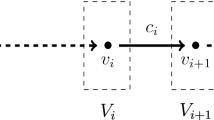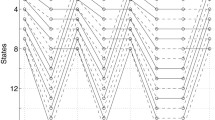Abstract
It has been shown by McEliece and Lin that convolutional codes can be represented by a minimal trellis structure in order to reduce the decoding complexity of the Viterbi algorithm. This trellis module has an irregular structure presenting sections with different number of states. In this paper we present the sectionalization of the minimal trellis module which yields a more compact and regular trellis representation (in terms of maximum number of states and total number of sections) with the same decoding complexity and distance spectrum of the minimal trellis module. We investigate the effects of the trellis sectionalization over the trellis and merge complexity measures. A set of rules are constructed to govern these effects. A list of the most compact sectionalized trellis modules with the same complexities than the minimal module is shown for codes of several rates. We show that various trellis topologies proposed in the literature are specific cases of the sectionalized minimal trellis.










Similar content being viewed by others
References
Uchôa-Filho, B. F., Souza, R. D., Pimentel, C., & Jar, M. (2009). Convolutional codes under a minimal trellis complexity measure. IEEE Transactions on Communications, 57(1), 1–5.
McEliece, R. J., & Lin, W. (1996). The trellis complexity of convolutional codes. IEEE Transactions on Information Theory, 42(6), 1855–1864.
Kienle, F., Wehn, N., & Meyr, H. (2011). On complexity, energy-and implementation-efficiency of channel decoders. IEEE Transaction on Communications, 59(12), 3301–3310.
Bougard, B. et al. (2004). Energy-scalability enhancement of wireless local area network transceivers. In Proceedings of the IEEE workshop on signal processing advances in wireless communications, Lisbon, Portugal (pp. 449–453).
Vardy, A. (1998). Trellis structure of codes. In V. Pless & W. Huffman (Eds.), Handbook of coding theory (pp. 1989–2117). Amsterdam: Elsevier.
McEliece, R. J. (1996). On the BCJR trellis for linear block codes. IEEE Transactions on Information Theory, 42(4), 1072–1092.
Lafourcade, A., & Vardy, A. (1996). Optimal sectionalization of a trellis. IEEE Transactions on Information Theory, 42(3), 689–703.
Katsiotis, A., Rizomiliotis, P., & Kalouptsidis, N. (2012). Flexible convolutional codes: Variable rate and complexity. IEEE Transactions on Communications, 60(3), 608–613.
Pedroni, B. U., Pedroni, V. A., & Souza, R. D. (2010). Hardware implementation of a Viterbi decoder using the minimal trellis. In Proceedings of the 4th international symposium on communication, control and signal processing (ISCCSP’2010), Limassol, Cyprus (pp. 1–4).
Tang, H.-H., & Lin, M.-C. (2002). On \((n, n-1)\) convolutional codes with low trellis complexity. IEEE Transactions on Communications, 50(1), 37–47.
Tang, H.-H., Lin, M.-C., & Uchôa-Filho, B. F. (2006). Minimal trellis modules and equivalent convolutional codes. IEEE Transactions on Information Theory, 2(8), 3738–3746.
Katsiotis, A., Rizomiliotis, P., & Kalouptsidis, N. (2010). New constructions of high-performance low-complexity convolutional codes. IEEE Transactions on Communications, 58(7), 1950–1961.
Rosnes, E., & Ytrehus, O. (2004). Maximum length convolutional codes under a trellis complexity constraint. Journal of Complexity, 20, 372–408.
Hug, F., Bocharova, I. E., Johannesson, R., & Kudryashov, B. (2009). Searching for high-rate convolutional codes via binary syndrome trellises. In Proceedings of IEEE international symposium on information theory (ISIT), Seoul, Korea (pp. 1358–1362).
Ranpara, S., & Ha, D. (1999). A low-power Viterbi decoder design for wireless communications applications. In Proceedings of the international ASIC conference, Washington D.C., USA (pp. 1–5).
Chan, M.-H., Lee, W.-T., & Chen, L.-G. (1996). IC design of an adaptive Viterbi decoder. IEEE Transactions on Consumer Electronics, 42(1), 52–62.
Garcia, M., Sendra, S., Lloret, J., & Canovas, A. (2011). Saving energy and improving communications using cooperative group-based wireless sensor networks. Telecommunication Systems, 52(4), 2489–2502. doi:10.1007/s11235-011-9568-3.
Pellenz, M. E., Souza, R. D., & Fonseca, M. S. P. (2010). Error control coding in wireless sensor networks. Telecommunication Systems, 44(1–2), 61–68.
Hussain, S., Azim, A., & Park, J. H. (2009). Energy efficient virtual MIMO communication for wireless sensor networks. Telecommunication Systems, 42(1–2), 139–149.
Chiasserini, C.-F., & Magli, E. (2004). Energy-efficient coding and error control for wireless video-surveillance networks. Telecommunication Systems, 26(2–4), 369–387.
Labeau, F. (2003). Complexity evaluation of nonbinary SOVA for sectionalized trellises. In Proceedings of the 41st Allerton conference on communication, control and computing, Monticello, USA (pp. 1–5).
Benchimol, I., Pimentel, C., Souza, R. D., & Uchôa-Filho, B. F. (2012). High-rate systematic recursive convolutional encoders: Minimal trellis and code search. EURASIP Journal on Advances in Signal Processing, 2012(243), 1–10.
Souza, R. D., Pimentel, C., & Muniz, D. (2012). Reduced complexity decoding of convolutional codes based on the M-Algorithm and the minimal trellis. Annals of Telecommunications, 67(11–12), 537–545.
Bocharova, E., & Kudryashov, B. D. (1997). Rational rate punctured convolutional codes for soft-decision Viterbi decoding. IEEE Transactions on Information Theory, 43(4), 1305–1313.
Cain, J. B., Clark, G. C, Jr, & Geist, J. M. (1979). Punctured convolutional codes of rate \((n-1)/n\) and simplified maximum likelihood decoding. IEEE Transactions on Information Theory, 25(1), 97–100.
Acknowledgments
This work was supported in part by FAPEAM, FACEPE and CNPq.
Author information
Authors and Affiliations
Corresponding author
Rights and permissions
About this article
Cite this article
Benchimol, I., Pimentel, C. & Souza, R.D. Low complexity trellis representations of convolutional codes via sectionalization of the minimal trellis. Telecommun Syst 59, 491–500 (2015). https://doi.org/10.1007/s11235-014-9909-0
Published:
Issue Date:
DOI: https://doi.org/10.1007/s11235-014-9909-0




